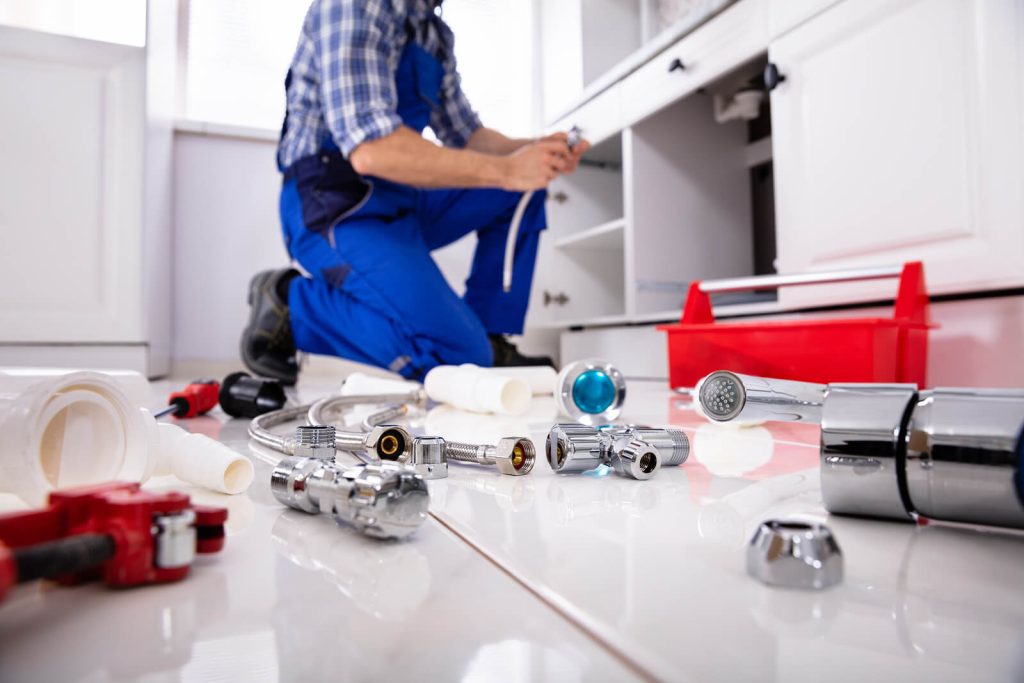Pro Tips: 9 Essential Plumbing Tools
Taking care of home plumbing issues takes knowledge, patience, and problem-solving skills. Of course, it also requires the right tools for the job!

Here are nine essential plumbing tools that our technicians use and recommend you have in your own toolbox.
- Pipe wrench – As the name implies, this type of wrench is specifically designed to work on pipes. There are actually many different versions of pipe wrenches for different applications. The most common version, the straight pipe wrench, has two jaws with metal teeth that provide a tight grip on round pipes. The jaws can be adjusted by spinning a nut. This allows the same wrench to be used for different sized pipes. Other examples of pipe wrenches are end-pipe wrench, compound leverage pipe, offset wrench, and strap wrench.
- Tongue-and-groove pliers – Commonly called channel locks, tongue-and-groove pliers are general tools that can be very effective at grabbing on to a pipe to tighten or untighten. There are a few great things about this tool. First, it’s adjustable so you can work on multiple sizes of pipes with the same piece of equipment. Second, a quality pair of channel locks will have rubber coverings on the handles, providing a better grip and comfort on your hands.
- Basin wrench – For getting into tight spaces, there’s no better tool than a basin wrench. This tool is typically used to work on faucets under sinks. The wrench self-tightens by wrapping a curved jaw around the pipe and locking in place. Using a long shaft and T-bar handle, you can turn the basin wrench and adjust the pipe from a farther distance than other types of wrenches. It takes some practice to get the hang of it but when you do, the basin wrench can be a lifesaver.
- Hole saw – When installing or repairing plumbing, you often have to work with pipes going through walls, floors, and ceilings. A hole saw is designed to cut clean, exact-sized circles into wood, concrete, or other solid materials. This part attaches to your power drill. In the middle of the saw is a drill bit that grabs on to the surface to hold the saw in place. The edge of the round saw have sharp teeth that rotate to cut a perfect hole.
- Hose cutter – Don’t let the name of this tool fool you – it’s actually made to cut pipes, not hoses. A typical model looks similar to a wrench but it works very differently. The two arms clamp down on the pipe, and then a blade comes down like a guillotine and cuts a straight line through the pipe. Different hose cutters are available for copper and PEX pipes.
- Drain auger – An auger, also known as a plumber’s snake, is the go-to tool for dealing with stubborn drain clogs that can’t be resolved with a plunger. An auger has a metal cable that is coiled in a canister. The cable is inserted down the drain until it reaches and breaks up the blockage. Simple augers are cranked by hand, while professional-level augers that plumber’s use are powered.
- Compression sleeve puller – When working on copper pipes, it can be very difficult to remove the compression sleeve that holds the joints together. This handy tool was specifically made for that job.
- Hack saw – A jack-of-all-trades, a hack saw is a trusted tool for plumbers. It can be used to cut PVC pipe, rough cutting holes in walls, or a million other uses.
- Metal file – Last but not least, a simple metal file is a must-have in the plumber’s toolbox. It’s used to smooth the edges of pipes after being cut. Any roughness or burrs left on the pipe can cause issues such as leaks
Professional plumbers in Oahu and Maui
Even with the right tools at home, some plumbing projects and repairs are better off left to the professionals. At Emergency Plumbing & Solar, we offer 24/7 emergency service and fair, upfront pricing. To schedule an appointment for your plumbing needs, call us today at (808) 691-9309.


